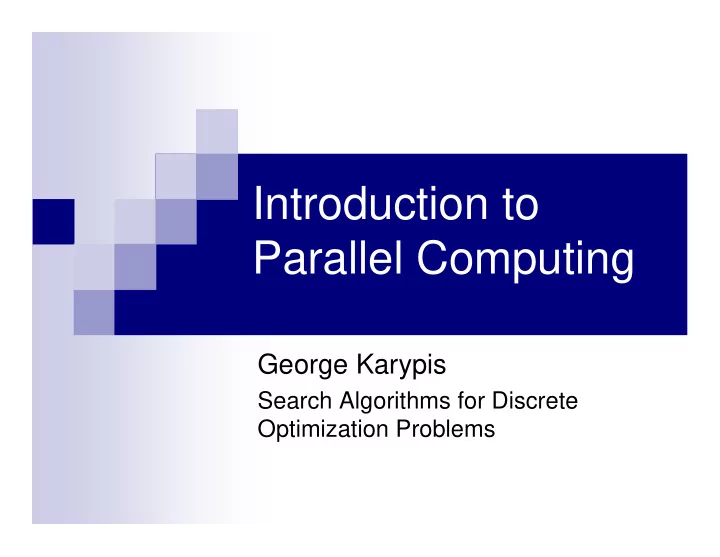

Introduction to Parallel Computing George Karypis Search Algorithms for Discrete Optimization Problems
Overview � What is a Discrete Optimization Problem � Sequential Solution Approaches � Parallel Solution Approaches � Challenges
Discrete Optimization Problems � A discrete optimization problem (DOP) is defined as a tuple of ( S, f ) � S : The set of feasible states � f : A cost function f : S -> R � The objective is to find the optimal solution x opt in S such that f ( x opt ) is maximum over all solutions. � Examples: � 0/1 integer linear programming problem � 8-puzzle problem
Examples � 0/1 Linear integer problem: � Given an mxn matrix A , vectors b and c , find vector x such that � x contains only 0s and 1s � Ax > b � f ( x ) = x T c is maximized. � 8-puzzle problem: � Given an initial configuration of an 8-puzzle find the shortest sequence of moves that will lead to the final configuration.
DOP & Graph Search � Many DOP can be formulated as finding the a minimum cost path in a graph. � Nodes in the graph correspond to states. � States are classified as either � terminal & non-terminal � Some of the states correspond to feasible solutions whereas others do not. � Edges correspond to “costs” associated with moving from one state to the other. � These graphs are called state-space graphs.
Examples of State-Space Graphs � 15-puzzle problem:
Examples of State-Space Graphs � 0/1 Linear integer programming problem � States correspond to partial assignment of values to components of the x vector.
Exploring the State-Space Search � The solution is discovered by exploring the state-space search. � Exponentially large � Heuristic estimates of the solution cost are used. � Cost of reaching to a feasible solution from current state x is � l ( x ) = g ( x ) + h ( x ) � Admissible heuristics are the heuristics that correspond to lower bounds on the actual cost. � Manhattan distance is an admissible heuristic for the 8-puzzle problem. � Idea is to explore the state-space graph using heuristic cost estimates to guide the search. � Do not spend any time exploring “bad” or “unpromising” states.
Exploration Strategies � Depth-First � Simple & Ordered Backtracking � Depth-First Branch-and-Bound � Partial solutions that are inferior to the current best solutions are discarded. � Iterative Deepening A* � Tree is expanded up to certain depth. � If no feasible solution is found, the depth is increased and the entire process is repeated. � Memory complexity linear on the depth of the tree. � Suitable primarily for state-graphs that are trees.
Exploration Strategies � Best-First Search � OPEN/CLOSED lists � A* algorithm � Heuristic estimate is used to order the nodes in the open list. � Large memory complexity. � Proportional to the number of states visited. � Suitable for state-space graphs that are either trees or graphs.
Trees vs Graphs � Exploring a graph as if it was a tree. � Can be a problem…
Parallel Depth-First Challenges � Computation is dynamic and unstructured � Why dynamic? � Why unstructured? � Decomposition approaches? � Do we do the same work as the sequential algorithm? � Mapping approaches? � How do we ensure load balance?
Overall load-balancing strategy
Some more details � Load balancing strategies � Which processor should I ask for work? � Global round-robin � Asynchronous (local) round-robin � Random � Work splitting strategies � Which states from my stack should I give away? � top/bottom/one/many
Analysis � How can we analyze these algorithms? � Focus on worst-case complexity. � Assumptions/Definitions: � a-splitting: � A work transfer request between two processors results in each processor having at least aW work for 0<a<=5 and W the original work available to one processor. � V(p) the number of work-transfer requests that are required to ensure that each processor has been requested for work at least once. � Then…
Analysis � Different load balancing schemes have different V(p) � Global round-robin: V(p)=O(p). � Asynchronous round-robin: V(p) = O(p 2 ) � Random: V(p) = O(plog(p))
Termination Detection � How do we know that the total work has finished? � Dijkstra’s algorithm � Tree-based termination
Parallel Best-First Challenges � Who maintains the Open & Closed lists � How do you search a graph?
Open/Closed List Maintenance � Centralized scheme � contention � Distributed scheme � non-essential computations. � periodic information exchange.
Searching graphs � Associate a processor with each individual node � Every time a node is generated is sent to this processor to check if it has been generated before. � Random hash-function that ensures load balancing. � High communication cost.
Speedup Anomalies
Recommend
More recommend